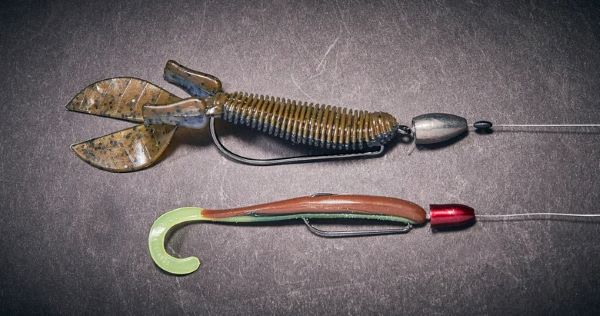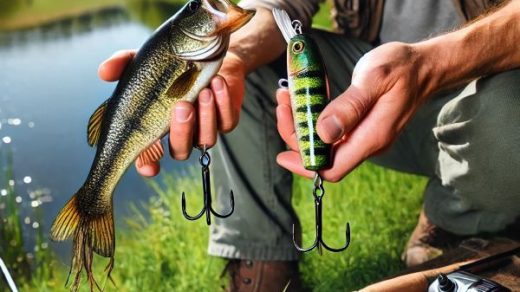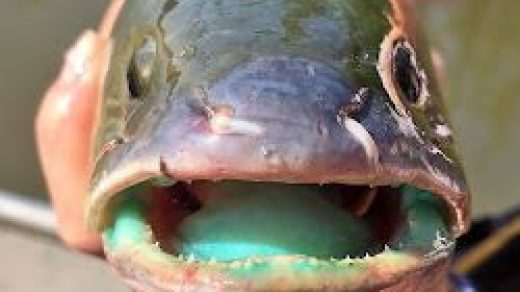
In the realm of angling, where patience meets precision, lies a technique revered by seasoned fishermen and novices alike—the Texas Rig. This time-honored method isn’t merely a means of presenting bait; it’s a strategic dance between angler and quarry, a delicate balance of deception and finesse. As we delve into the intricacies of this renowned rigging technique, we uncover not just a method, but a philosophy—a philosophy rooted in understanding the nuances of aquatic ecosystems and the behaviors of elusive bass.
The Texas Rig stands as a testament to the adaptability and ingenuity of anglers, offering a versatile approach that transcends the confines of specific environments or seasons. From the tranquil waters of secluded ponds to the sprawling expanses of murky reservoirs, this rig remains a steadfast companion for those who seek to outwit their elusive prey.
Join us on an exploration of the Texas Rig—a journey that delves deep into the artistry of bass fishing, where every cast is a story waiting to unfold, and every tug on the line ignites a rush of anticipation. As we unravel the secrets of this revered technique, prepare to elevate your angling prowess and embark on a quest for trophy-sized bass like never before.
Deciphering the Anatomy of the Texas Rig
At the heart of the Texas Rig’s effectiveness lies its simplicity—a straightforward setup comprised of a few key components meticulously assembled to entice even the most discerning bass. Understanding the anatomy of this rig is paramount to its success, as each element plays a crucial role in its presentation and performance.
The Hook: Central to the Texas Rig is the hook, a fundamental tool in any angler’s arsenal. Opting for a wide gap or offset hook ensures ample space for bait penetration and facilitates solid hook sets, crucial when engaging with the often-sly bass. The hook’s size should complement the chosen bait, allowing for a seamless integration that appears natural to the discerning eye of the fish.
The Weight: A hallmark feature of the Texas Rig is its incorporation of a bullet or cylindrical weight, strategically positioned above the hook to achieve the desired depth and presentation. This weight serves multiple functions, acting as both an anchor to keep the bait in the strike zone and a means of imparting subtle movements that mimic natural prey. Selecting the appropriate weight depends on factors such as water depth, bottom composition, and desired lure action, with heavier weights suited for deeper waters and lighter ones for shallow, weedy areas.
The Bait: Perhaps the pièce de résistance of the Texas Rig is the bait itself—a tantalizing offering designed to evoke the predatory instincts of bass lurking beneath the surface. From soft plastic creatures to lifelike imitations of prey species, the options are as diverse as the ecosystems they inhabit. Common choices include soft plastic worms, crawfish imitations, creature baits, and swimbaits, each boasting unique characteristics that cater to different fishing conditions and bass preferences. Experimentation is key, as varying colors, sizes, and styles can elicit varying responses from bass, ensuring adaptability in the face of changing conditions.
The Leader: Completing the ensemble is the leader, a section of line connecting the hook to the main fishing line. Typically crafted from fluorocarbon or monofilament, the leader serves as a stealthy link between angler and quarry, offering abrasion resistance and low visibility to enhance presentation. Its length can vary depending on water clarity and structure, with longer leaders providing added stealth in clear waters and shorter ones facilitating precise casts in dense cover.
Selecting the Right Gear for Texas Rig Fishing
Equipped with an understanding of the Texas Rig’s anatomy, anglers must now turn their attention to selecting the appropriate gear to maximize their success on the water. From rods and reels to lines and terminal tackle, each component of an angler’s arsenal plays a crucial role in ensuring a seamless fishing experience.
Rod Selection: Central to the angler’s toolkit is the fishing rod, a versatile instrument that serves as the conduit between angler and fish. When selecting a rod for Texas Rig fishing, several factors come into play, including length, action, and power. A medium to medium-heavy rod with a fast action is ideal for imparting the necessary sensitivity and responsiveness required for detecting subtle strikes while providing ample backbone for effective hook sets. A length of 6’6″ to 7’6″ offers optimal casting distance and control, allowing anglers to precisely place their presentations in tight cover or open water.
Reel Choice: Complementing the fishing rod is the reel, a crucial component that facilitates smooth line retrieval and efficient hook sets. When targeting bass with the Texas Rig, a baitcasting reel reigns supreme, offering superior casting accuracy and control compared to spinning reels. Opt for a reel with a high gear ratio (7.1:1 or higher) to quickly pick up slack line and efficiently work baits through cover, enhancing overall productivity on the water.
Line Options: Selecting the appropriate fishing line is paramount to the success of any angling endeavor, and Texas Rig fishing is no exception. Fluorocarbon and braided lines are favored choices among seasoned anglers, each offering distinct advantages suited to different fishing conditions. Fluorocarbon lines boast low visibility and excellent abrasion resistance, making them well-suited for clear water or situations where stealth is paramount. Braided lines, on the other hand, offer unmatched strength and sensitivity, ideal for fishing in heavy cover or extracting bass from dense vegetation with ease.
Terminal Tackle: Completing the angler’s setup are various terminal tackle components essential for rigging and presentation. A quality selection of hooks, weights, and swivels ensures versatility and adaptability on the water, allowing anglers to customize their rigs to suit prevailing conditions and bass preferences. Consider incorporating tungsten or brass weights for their sensitivity and compact profile, enhancing lure action and increasing sensitivity to strikes.
Mastering Presentation Techniques
With the Texas Rig’s anatomy understood and the appropriate gear selected, anglers must now turn their attention to mastering presentation techniques that will entice even the most cautious bass. From subtle retrieves to strategic bait placement, the art of presentation is where skill and strategy converge, offering anglers an opportunity to outsmart their quarry with finesse and precision.
Casting Accuracy: The foundation of successful Texas Rig fishing lies in the ability to accurately cast your presentation to precise targets, whether it be submerged structure, weed beds, or other likely bass holding areas. Practice casting in various conditions and environments to hone your accuracy and proficiency, aiming for pinpoint precision to maximize your chances of enticing a strike.
Bottom Contact: Maintaining constant contact with the bottom is paramount when fishing the Texas Rig, as it allows anglers to effectively mimic the movements of natural prey species and elicit strikes from opportunistic bass. Pay close attention to your line and rod tip, adjusting your retrieve speed and technique to ensure consistent contact with the substrate below. Utilize the weight of your rig to feel for changes in bottom composition, such as rocks, gravel, or vegetation, which often serve as prime ambush points for bass.
Cadence and Retrieval Techniques: Experimentation is key when it comes to finding the optimal cadence and retrieval technique for enticing strikes on the Texas Rig. Start with a slow, steady retrieve, imparting subtle twitches and pauses to mimic the erratic movements of wounded or distressed prey. Pay attention to the response of bass in your local waters, adjusting your cadence and retrieve speed accordingly to trigger strikes from even the most hesitant fish.
Presentation Variations: Versatility is a hallmark of successful Texas Rig fishing, and anglers must be prepared to adapt their presentation techniques to suit changing conditions and bass behavior. Consider varying the size, color, and profile of your bait to match the prevailing forage and environmental factors, enticing bass with a diverse array of offerings. Experiment with different rigging styles, such as Texas Rigging with a pegged weight or incorporating a weedless setup for fishing in heavy cover, to expand your repertoire and maximize your chances of success.
Strategies for Success: Texas Rig Fishing Tips and Tactics
As anglers embark on their Texas Rig fishing adventures, employing effective strategies and tactics can make all the difference between a lackluster outing and a day filled with memorable catches. From leveraging seasonal patterns to capitalizing on bass behavior, mastering the art of strategy is essential for maximizing success on the water.
- Understanding Seasonal Patterns: Bass behavior is heavily influenced by seasonal changes, and savvy anglers must adapt their Texas Rig fishing strategies accordingly. During the spring months, bass are often found in shallow waters near spawning grounds, making them susceptible to shallow-running presentations like the Texas Rig worm or creature bait. As summer arrives and water temperatures rise, bass seek refuge in deeper, cooler waters, necessitating a shift to deeper-running rigs and slower presentations to entice strikes from lethargic fish. In the fall, bass feed voraciously in preparation for the winter months, making it an ideal time to employ fast-moving presentations like swimbaits or spinnerbaits rigged Texas style to mimic fleeing baitfish.
- Targeting Structure and Cover: Bass are opportunistic predators that often lurk near submerged structure and cover, waiting to ambush unsuspecting prey. When fishing the Texas Rig, focus your efforts on key structural elements such as points, ledges, and drop-offs, as well as dense cover like submerged vegetation, fallen trees, and rock piles. These areas serve as natural ambush points for bass and are prime locations to deploy your Texas Rig presentation for maximum effectiveness.
- Adjusting Presentation Depth: One of the key advantages of the Texas Rig is its versatility in adjusting presentation depth to match prevailing conditions and bass behavior. Experiment with different weight sizes and placement to control the depth at which your bait runs, allowing you to effectively target bass holding at varying depths throughout the water column. Pay attention to subtle changes in bottom composition and structure, adjusting your rig accordingly to ensure your bait remains in the strike zone for optimal periods.
- Embracing Stealth and Patience: Success in Texas Rig fishing often hinges on a combination of stealth and patience, as anglers must approach their target areas with finesse and wait for the opportune moment to strike. Avoid spooking wary bass by employing a stealthy approach, minimizing noise and disturbance on the water. Once in position, exercise patience and persistence, allowing your Texas Rig presentation ample time to entice strikes from cautious fish. Remember, sometimes the biggest bass require the most patience to coax into biting.
Troubleshooting Common Challenges
While Texas Rig fishing offers anglers a versatile and effective approach to targeting bass, encountering challenges is an inevitable part of the angling experience. From snagged baits to finicky fish, understanding how to troubleshoot common issues can mean the difference between frustration and success on the water. Below, we explore some of the most prevalent challenges faced by Texas Rig anglers and offer practical solutions to overcome them.
- Dealing with Snags: Snags are an unavoidable hazard when fishing in areas with dense cover or rocky bottom structure. When your Texas Rig becomes lodged in debris or vegetation, resist the urge to forcefully yank it free, as this can result in lost baits or damaged tackle. Instead, employ a gentle, steady pressure to coax the rig out of the snag, utilizing the bend and flex of your rod to dislodge it without risking breakage. If the snag proves stubborn, try repositioning your boat or casting from a different angle to access the snagged area from a new perspective.
- Preventing Line Twists: Line twists are a common nuisance that can hinder casting distance and accuracy, as well as compromise the integrity of your fishing line. To prevent line twists when fishing the Texas Rig, periodically check your line for signs of twisting or coiling and take steps to rectify the issue before it worsens. Avoid overfilling your reel spool, as excessive line tension can exacerbate twisting problems. Additionally, consider incorporating a barrel swivel or snap swivel into your rig setup to minimize line twist during retrieves, allowing for smoother line flow and reduced friction.
- Adapting to Changing Conditions: Weather and environmental factors can significantly impact bass behavior and feeding patterns, requiring anglers to adapt their Texas Rig fishing strategies accordingly. During periods of inclement weather or low light conditions, bass may become more aggressive and willing to strike larger, more visible presentations like jigs or spinnerbaits rigged Texas style. Conversely, in bright, high-pressure conditions, downsizing your Texas Rig presentation and adopting a finesse approach can yield better results. Stay attuned to changes in weather, water temperature, and atmospheric pressure, adjusting your tactics accordingly to stay one step ahead of the fish.
- Fine-Tuning Rigging and Presentation: Achieving the perfect Texas Rig setup involves a delicate balance of rigging and presentation techniques, and fine-tuning these elements can often mean the difference between success and failure on the water. Experiment with different hook sizes, weights, and bait styles to find the optimal combination that elicits strikes from bass in your local waters. Pay close attention to subtle changes in fish behavior and adjust your rigging and presentation accordingly, whether it be Texas Rigging with a pegged weight for a more streamlined profile or imparting subtle twitches and pauses to trigger reaction strikes from wary bass.
Conclusion: Elevating Your Bass Fishing Game with the Texas Rig
In the realm of bass fishing, mastering the art of the Texas Rig is akin to unlocking a treasure trove of angling secrets—a journey filled with challenges, triumphs, and endless opportunities for growth. Throughout this exploration of the Texas Rig, we’ve delved into its intricacies, from deciphering its anatomy to mastering presentation techniques and overcoming common challenges. Along the way, we’ve uncovered the essential elements that define the Texas Rig as not just a fishing technique, but a philosophy—an approach to angling that celebrates adaptability, innovation, and a deep understanding of bass behavior.
As anglers, our pursuit of trophy-sized bass is a quest that transcends the mere act of catching fish; it’s a pursuit of knowledge, skill, and a profound connection to the natural world. The Texas Rig serves as our trusty companion on this journey, offering versatility, effectiveness, and endless possibilities for exploration. Whether we find ourselves casting into the tranquil waters of a secluded pond or battling the elements on a sprawling reservoir, the Texas Rig remains a steadfast ally, guiding us towards success with each carefully calculated cast.
So, as you prepare to embark on your next bass fishing adventure, armed with the knowledge and expertise gained from our exploration of the Texas Rig, remember to embrace the challenge, savor the moments of triumph, and never cease in your pursuit of angling excellence. With the Texas Rig as your guide, the possibilities are endless, and the next trophy bass awaits just beyond the horizon. Happy fishing!




